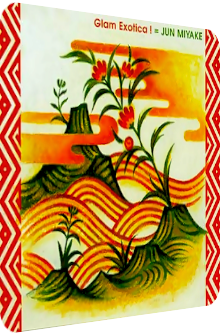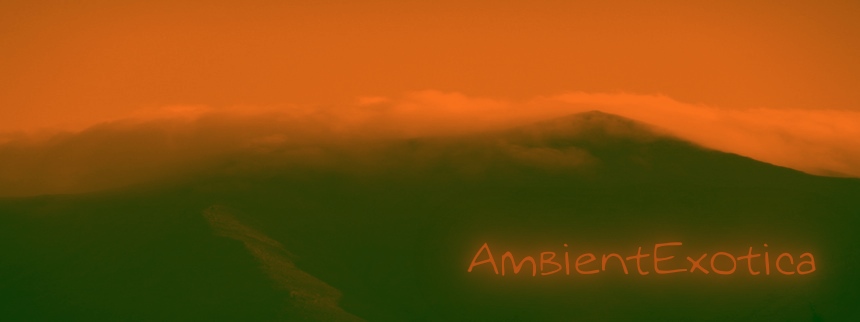
Jun Miyake
Glam Exotica!
1999
Glam Exotica! is an outstandingly exotic work by Kyoto-bred composer and multi-instrumentalist Jun Miyake (born 1958) that multiplexes Japanese (s)traits, encapsulates escapism, submits pipe dreams and explores faraway places. Released in 1999 on Beams Records and featuring the talent of dozens of musicians – among them mallet instrumentalist Midori Takada, guitarists Hiroki Komazawa and Masahiro Itami, harpist Tomoyuki Asakawa, percussionists Mataro Misawa and Midori Takada as well as eight dedicated violinists –, the 12 tracks of Glam Exotica! venture into various genres, moods, tempos and surroundings as each and every Exotica album tends to, but does so in a coherent, tastefully concentrated way. Alas, this description is too whitewashed and arbitrary, but has to do for the moment, as the magic of this album will of course be described in greater detail over the course of this review.
The artist himself is bountiful when it comes to the driving factor of this album, for he has a differing – and highly personal – definition of Exotica in store: "I've always had mysterious, exotic encounters in foreign lands. No matter where I go, elfin creatures I call exotica surface on tiptoe. […] To help them flourish, I propose Music Colonialism. Let glamorous exoticas breed across the space-time continuum." If this approach lets you raise a brow or two (or even three), let me assure you that these inordinate fantasies are not mirrored in the music itself, this is no concept album with a cunning storyboard. But the idea of Music Colonialism is a great one and very astute in view to Glam Exotica! and its polyhedric influences. With this catchy genre description in mind, I am approaching a special work, one whose force is hard to pinpoint, but spread all over the compositions… off which one, at least, is a vivid take on an Exotica gold standard.
An album with a piece called Rain Forest cannot be an utterly bad one, especially not when it is gyring around the Exotica nucleus. Jun Miyake and his band deliver a spellbinding opener with a sense of movement, a safari through the titular jungle. Midori Takada’s polyphonic marimba not only evokes the ligneous underbrush, but an Oriental heat qua its dubious tone sequences. Sizzling drums, maraca sprinklers, harp twangs and a superimposition of Jun Miyake’s flügelhorn and an adjacent trombone make this opener a truly verdured take; if that wasn’t enough already, caterwauling cats, histrionic chants and vulturine vesicles let Rain Forest come to life. The next destination feels hazy and surreal: Lotus Isle enthralls with bamboo rods, tubular gamelan chimes and mystical trumpet spirals. The mood is soothing and intense, albeit laid-back, bongos and acoustic guitars provide rhythmic elements of a largely Ambient-focused mélange. Transcendental, humid and enigmatic, Lotus Isle is strongly luring. Fans of Don Ellis’ Haiku (1973) need to investigate!
Yet another delightful piece is up next, the super-exotic River Of Gold. Presumably influenced by the arrangements of Les Baxter, this long take south of the six-minute mark sees Jun Miyake deliver aureate piano chords in close proximity to a small orchestra of eight violinists. Merging into Middle Eastern timbres, leaving room for the echoes of tonewoods and surprising with Satoshi Murakawa’s vocals akin to Don Tiki’s sleazy savage Delmar DeWilde, River Of Gold is Exotica in technicolor with a cautiously murky undercurrent. While Mosquito Path pays homage to the concept of vintage African Exotica with its many marimba droplets, off-key flute phantasms, shawm-like trumpet cascades and lack of Funk or Bop markers, Erik Satie’s Gnossiene #1 is the consequent subjugation to these very genres and surprises with a transmuted thicket of jungular percussion, volcanic drums, smoking-hot organ accompaniments and ever-fizzling hi-hats. Indian alto flutes, archetypical double bass billows and cheeky marimba blebs form the base frame for the inevitable electric guitar, played by Masahiro Itami, to shine.
Pico Birds, meanwhile, is a mixture between Jun Miyake’s afore-featured Lotus Isle and Warren Barker’s Exotica opus A Musical Touch Of Far Away Places (1959), known for its use of Hollywood star William Holden’s private collection of exotic instruments. Sheena Miyake provides the vocals, her voice being tripled, resembling a choir of fairies that is fueled by the howling ghost-like winds that derive from a so-called Whacho’s tube. Tomoyuki Asakawa’s argentine harp licks protrude the fog of this most mystical arrangement to grace Glam Exotica!, notwithstanding the film noir atmosphere in its second half, driven by Jun Miyake’s trumpet. A small letdown follows in the shape of Lost Honeymoon, a Balkan-inspired Tarantella/Dixieland hybrid with warped bass clarinets and like-minded trumpet serpentines. The drums are feisty and the sun-lit piano chords wonderfully staggering and Italo-like, but still, the atmosphere of this song feels de trop amid the album’s specific endemics.
The second rendition of the album comes in the gestalt of Ary Barroso, or to be more precise, the eternal Brazil, a superbly tropical and silkened interpretation supercharged with mildly Latin piano cycles, Masahiro Itami’s insouciant guitar riffs, Hiroki Komazawa’s languorously elasticized steel guitar injections as well as Tomo Yamaguchi’s bongo copse. The melody remains recognizable throughout, ocean waves reach the shore, everything feels slick but not overproduced. Up next is Stones Bearing Flowers, a Bolero awash with light. Sung by Shizuru Ohtaka, improved by easygoing bongo structures and further carved out by stupefyingly luminescent ukulele strums in technicolor, the ambience is magnificent in the first half and slightly less exotic in the second half when the stacked woodwinds interweave the Occident.
Whereas the sternly Japanese Lokasa lets aqueous marimba droplets and uplifting chants clash with rufescent Panjab violins and a nocturnal precariousness, Raft Of Love is a gorgeous sea shanty that could have come directly from Madeira due to its accordion in the spotlight, the pianica infusion, chintzy bonfire guitars and Satoshi Murakawa’s improvident velvet aspiration. Add gleaming horns to the scenery, and a tramontane panorama unfolds. The short finale Postcard clocks in at a mere 90 seconds and is a Hapa Haole-inspired piece of strongly Hawaiian tone sequences; steel guitars, ukuleles and even a choir of hula girls made it to the clear skies of this highly ephemeral but definitely exotic apotheosis.
Glam Exotica! is a towering nod, homage, reverence and tribute to the Exotica genre. It does not take a genius, let alone a devoted reviewer to point that out, true, but the scope of the production, the care and commitment of Jun Miyake and his fellows cannot be grasped in the previous sentence. And even more depressingly, I am not sure a full-length review can transparently expound the iridescent material of this release either. I just know that this wondrous sapphire is timeless in its own way. By using the term timeless, I do not want to shoot Miyake’s artifact to Mount Olympus where it would be united with works of truly secular importance, but rather state that the weight of time is annihilated on this release, although in a metaphorical sense, of course. Whatever one expects from a nearly millennial, contemporary Exotica release, no artist or collective can prudently beat the magical 50’s and 60’s. No matter how vivid the compositions are and how hard these combos try, the good old times will always hailed as the benchmark.
Glam Exotica!, despite its overly posh title, is not part of this process and neutralizes the music lover’s presumption: qua its status as a Japanese creation, it does feel somewhat magical and captivating right from the get-go, but its genre potpourri is no legerdemain, no self-sustaining cavalcade of gimmicks, ploys and curlicues. Each song is well-balanced, warmhearted even within the shadier interstices, and a fresh approach. Other artists spice their albums with Oriental seasonings to create a micro world that lasts for a track or two, but Jun Miyake’s approach is as dedicated as it is munificent, always with a knowing wink. The secret lies in the diffraction: Shintoist spirits merge with Latin schmaltz which itself is entangled in the red sky of a contemplative dawn. Glam Exotica! never feels like a patchwork, it is distantly, infinitesimally similar to Tipsy’s brightly colored Trip Tease (1996) and Uh-Oh! (2001), but created for the connoisseur of Jazz, the ambiance of World music… and so strikingly exotic that I can wholeheartedly recommend it to every Exotica fan, no matter his or her preferred decade, style or way of arranging.
Exotica Review 302: Jun Miyake – Glam Exotica! (1999). Originally published on Jan. 4, 2014 at AmbientExotica.com.
